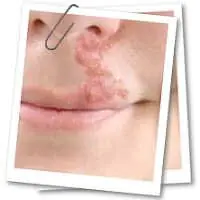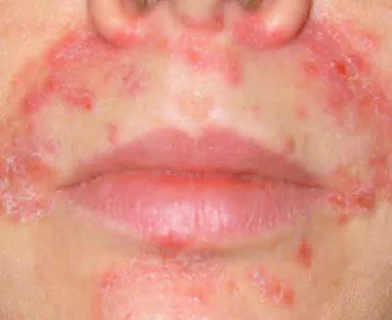
The causes of a rash under the nose can be different. One of them is perioral dermatitis. This disease does not occur often, mainly in women. It manifests itself by the appearance of small reddish pimples on the skin of the face, in the area of the mouth and nose.
Other causes of such a rash can be: lack of skin care, allergic reactions, infection with the herpes virus, etc.
Rash under the nose: causes
The appearance of a rash under the nose may be associated with exposure to ultraviolet radiation on the skin, a decrease in the body's immune properties, increased sensitivity to allergens, the use of various creams and ointments, and high sensitivity of the facial skin to negative factors. In addition, there may be internal causes of the formation of a rash, such as pathologies of the digestive system, disruption of the normal functioning of the endocrine system, nervous strain and stress.
In children, the appearance of pimples in most cases indicates the presence of dermatitis. In such cases, you should contact your pediatrician and visit a dermatologist, especially if the child is less than three years old. You cannot give your baby any medications without a doctor’s prescription.
Non-pathological causes of a rash under the nose in children can be:
- dirt . Children often touch their faces with dirty hands and put various objects into their mouths. This may lead to rashes. If, apart from the rash, there are no symptoms of the disease, then you need to strengthen control over the baby’s hygiene, and lubricate problem areas with baby cream;
- weather conditions . Often, after a walk in windy or frosty weather, a child may develop small pimples or areas of damaged skin. You can cope with them with the help of baby cream, Bepanten, Summed and other similar products.
Rashes under the nose, in the area of the nasolabial triangle, are often found in adults. The reason for this is the increased activity of the fat glands in this area. When bacteria enter the pores of the glands, an inflammatory process can begin, which leads to the formation of pimples, blackheads and rashes. However, the causes of a rash under the nose can be not only local; some serious diseases can provoke such a reaction.
The most common cause of acne and rashes near the nose is insufficient hygiene. If you are prone to developing a rash, you should use special products that reduce skin oiliness and have anti-inflammatory and antibacterial effects.
Of the common factors leading to rashes under the nose and on the skin of the face, hormonal imbalance is considered the most common. In women, pimples can occur during pregnancy or during menstruation. Also, pathologies of the cardiovascular and endocrine systems can cause a similar reaction.
Types of acne under the nose
There are several types of rashes under the nose. They differ in size, appearance, quantity and reasons for their appearance. Thus, small white pimples and blackheads usually occur due to lack of care. They are sebum or dirt particles trapped in the pores. White pimples are formed when a pore is clogged; subsequently they often become purulent and significantly increase in size, drawing surrounding tissues into the inflammatory process.
Various dermatitis appear as a small red rash on the face. They can occur as a result of an allergic reaction to ointments and creams, detergents or cosmetics used for treatment.
Rashes with dermatitis appear gradually, first the skin turns red, and then small nodules or pimples form on it. They may merge with each other, spread to other areas, but the lips and skin around them remain free of the rash. Itching and discomfort are often absent. Treatment of such rashes consists, first of all, in eliminating the cause of the allergy, and also includes a gentle diet and skin care.
Before acne appears, there is usually redness of the skin and the formation of several small pustules. Such rashes are accompanied by itching and pain. Acne under the nose can have several causes:
- Insufficient care.
- Hormonal disruptions and changes. Acne often develops in adolescents during adolescence, women expecting a child or who have recently given birth.
- Wrong diet.
- Allergies to medications, food or household chemicals.
- Stressful situations.
- Hot weather or increased physical activity, which is accompanied by profuse sweating.
- Internal problems of the body.
Purulent pimples under the nose are often isolated, less often massive. The reasons for their appearance are similar to the reasons for the formation of acne. Often such rashes occur due to a lack of vitamins and minerals in the body, weakened immunity and internal diseases. The most common external causes are: improper skin care, poorly selected diet, exposure to adverse factors, etc.
Subcutaneous pimples are not as noticeable in appearance as purulent ones. They may appear as a bump of skin with no change in color, but may be reddish or pink. Such rashes are usually accompanied by severe pain. The reasons for their appearance can be various microorganisms, hypothermia, skin contamination and other factors. Subcutaneous pimples often become inflamed and purulent.
Preventing rashes under the nose
Preventing a rash under the nose involves changing your diet and lifestyle. It includes:
- A complete proper diet;
- Refusal of drugs that cause an allergic reaction;
- Regular facial skin care, including mandatory cleansing;
- Walks in the open air;
- Full, restful sleep;
- To give up smoking;
- Taking vitamin complexes;
- Nourishing facial masks and peelings.
Treatment of rash under the nose
Treatment of a rash under the nose includes, first of all, proper facial care. You should not squeeze out the pimples that have formed or try to hide them under a thick layer of cosmetics. Problem areas should be cleaned twice a day using special lotions; these areas should also be treated with hydrogen peroxide and ointments that have anti-inflammatory and antibacterial effects should be applied to them. It is better to avoid decorative cosmetics during treatment.
Among the folk remedies that help in such cases are compresses and rubbing with herbal decoctions (sage, yarrow, chamomile, calendula and others), treating the affected area with tea tree oil, aloe juice, birch decoction, and calendula tincture. You can also conduct a course of steam baths with mint, chamomile, burdock and other herbs.

Have you noticed a pimple on your nose and are trying to find out the reason for its appearance? The causes of pimples around the nose can be the most unexpected, but most often their appearance is associated with a malfunction of your sebaceous glands. Their job is to create a natural protective film called sebum. If the clot gets larger, it clogs the pores and ducts through which the subcutaneous oil cannot escape. fat, which causes acne to appear on the skin.
If such pores still have an opening, then blackheads are formed. If sebum gets into the canal, a cyst appears, which is also called a comedon. If the inflammatory process begins, red large pimples appear, which are known as the inflamed form of acne around the nose.
Pimples around the nose: causes
Experts, usually answering the question “what causes acne around the nose?”, also add that acne can appear not only in young people. Older and middle-aged people are also familiar with acne on the body and face, including the area around the nose.
In teenagers, the causes of acne are most often associated with hormonal surges during puberty. When adults have acne under the nose, on the nose or elsewhere, it is likely a symptom of a circulatory, endocrine or immune system disease, or an infectious disease. It is believed that even one pimple on the tip of the nose is the first sign of heart, stomach or liver problems.
Among the possible causes of acne around the nose are stress, lack of vitamin A, hormonal imbalances in the body and the use of poor cosmetics. The appearance of acne around the nose cannot be considered as a separate subject of skin disorder and the cause of acne, since the causes of their appearance are closely related to other general reasons for the appearance of acne on the face and the whole body in particular. But if you have a large pimple in the area around the nose, then its appearance can be considered as a separate subject and a problem of this particular part of the skin of the face, as in our case, the area around the nose.
White, small, red pimples around the nose
In most cases, these types of acne can be found around the nose:
- Itchy small pimples Their usual place of appearance is around the nose and mouth. Doctors believe that this is a sign of an acute condition of herpes.
- White Pimples They resemble white dense nodules If you have white pimples, the easiest way to remove a pimple on your nose is with electrocoagulation.
- Red pimples are the result of an inflamed cyst. These acne are painful and several pimples can cluster together to form bumps on the nose.
- Pustular white pimples may appear as a result of staph infections of red pimples. The appearance of pus pimples can be very painful, so you need to start treating these pimples around the nose as soon as you notice the first signs of their appearance.
- Pink pimples The reason for their appearance is the affect of the appearance of Demodex mites under the skin of your nose. Such pimples on the nose appear simultaneously with gastrointestinal disorders. Under the influence of pink pimples, your skin becomes rough, thickens and becomes covered with tubercles.
Diagnosis of the causes of acne around the nose
Diagnosing and identifying the exact cause of pimples around the nose can only be done by a specialist after you have undergone a serious examination. If you notice any worrying pimples around the nose, then consult a doctor immediately, as skin blemishes are not just small things. If you notice that pimples appear not only on the surface but also inside your nose, and their appearance recurs on a regular basis, be very careful. It's time to seek help from a clinic and consult a dermatologist.
As a rule, the patient is prescribed a complex treatment: a ten-day course of treatment with metronidazole, both in tablets and in the form of an ointment for external treatment of problem areas. In more complex cases, doctors prescribe antibiotics: taking Acyclovir and using external clindamycin. In addition, it is recommended to be sure to take vitamins appropriate for your age and needs. In addition, you should also completely stop smoking and drinking alcohol.
There are some undesirable actions that you could try before you see a doctor Never squeeze pimples Avoid squeezing pimples Such actions can cause the subcutaneous pimple on the nose to release pus onto the skin or even into the bloodstream, which is much worse And this will be followed by repeated infection, and the pimples will not only multiply on the nose, but will also take on a more inflamed appearance on the face in the future.
How to get rid of acne around the nose
Benzoyl peroxide may dry out the skin or cause burning and redness at the site of application. Use it only as directed by a doctor.
Try these treatments for acne around your nose at home for at least three to four weeks. If your skin condition and the number of pimples around your nose do not improve, make an appointment with your dermatologist. If you have moderate to severe acne, see a dermatologist before trying any of these methods in order to receive professional recommendation and advice on their treatment in your case of illness.
Without this professional advice, you could be causing more problems than you think. Your dermatologist may recommend other approaches to treating acne around the nose.
A dermatologist may recommend prescription medications or alternative treatments such as microdermabrasion, chemical peels, or light laser treatments. They can also help remove pimples immediately using a special tool called a comedone extractor.
Salicylic acid can also cause skin irritation and burning if used incorrectly. It should be used only for its intended purpose.
To help prevent acne around the nose and the rest of the face, wash your face regularly every day, twice a day. You should also cleanse your face after any sweaty or physical activity. Large amounts of sweat can increase the incidence of acne.
Gently wash your face, applying cleanser in gentle circular motions. Do not wash your face too much. More than twice a day is not recommended.
Some cosmetics can irritate the skin and cause acne. If you have problems with acne on your nose, consider going makeup-free or wearing as little makeup as possible. When choosing foundations, look for oil-free and non-homogeneous makeup bases that won't clog your nose. pores.
Chemicals and oils in makeup, even when using hypoallergenic products, can clog your pores and cause breakouts.
This helps reduce clogged pores.
You can also dry out pimples on your nose using sea salt.
- Take one teaspoon of sea salt and stir it into three teaspoons of hot water.
- Stir to dissolve the sea salt.
- If you don't want to use the mask all over your face, take a Q-tip and dip the tip into your mixture and apply the solution where needed.
- Just make sure you avoid getting the mixture near your eyes.
- Leave the mixture for 10 minutes.
Don't leave it on for too long Sea salt draws out water and can dry out your skin too much.
Rinse your face completely with cool or warm water.
Related and recommended questions
38 replies





This is perioral dermatitis!
How long have you been using hydrocortisone?
What else is on the skin and for how long?
Do you tolerate medications well?
How old are you?

This is perioral dermatitis.
Hydrocortisone, sinaflan and other hormonal preparations on the face are strictly prohibited! .
This is a vicious circle: if you apply it, it gets better, if you stop, it gets worse!
Not breastfeeding?
If not, then use:
Tab. "Unidox Solutab" - half a tablet * 1 time per day for up to 20 days.
Do not drink alcohol, milk or sunbathe!
Rosamet cream - apply a thin layer to problem areas every morning for up to 1-2 months.
Erythromycin ointment - apply a thin layer to problem areas every evening for up to 1 month.
Wash your face with boiled water!
Unsubscribe after 20 days with a photo or earlier if necessary!





Hello !
This is perioral dermatitis.
Pimafucort is contraindicated.
Use:
- Erythromycin ointment - apply a thin layer to the rash every evening for up to 1 month.
— Rosamet cream — apply a thin layer on the rash every morning for up to 1 month.


Site search
What should I do if I have a similar but different question?
If you did not find the information you need among the answers to this question, or your problem is slightly different from the one presented, try asking an additional question to the doctor on the same page, if it is on the topic of the main question. You can also ask a new question, and after a while our doctors will answer it. It's free. You can also search for the information you need in similar questions on this page or through the site search page. We will be very grateful if you recommend us to your friends on social networks.
Medical portal 03online.com provides medical consultations via correspondence with doctors on the website. Here you get answers from real practitioners in your field. Currently, on the site you can get advice in 48 areas: allergist, anesthesiologist-resuscitator, venereologist, gastroenterologist, hematologist, geneticist, gynecologist, homeopath, dermatologist, pediatric gynecologist, pediatric neurologist, pediatric urologist, pediatric surgeon, pediatric endocrinologist, nutritionist, immunologist a , infectious disease specialist, cardiologist, cosmetologist, speech therapist, ENT specialist, mammologist, medical lawyer, narcologist, neurologist, neurosurgeon, nephrologist, oncologist, oncourologist, orthopedist-traumatologist, ophthalmologist, pediatrician, plastic surgeon, proctologist, psychiatrist, psychologist, pulmonologist, rheumatologist, radiologist , sexologist-andrologist, dentist, urologist, pharmacist, herbalist, phlebologist, surgeon, endocrinologist.
We answer 96.3% of questions.



